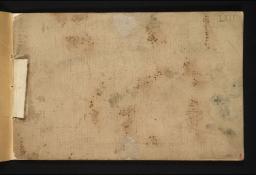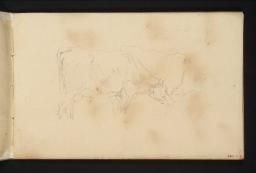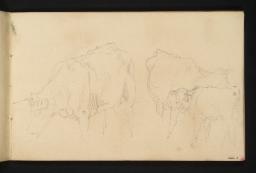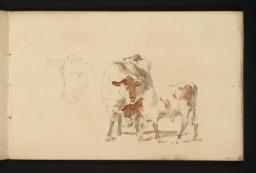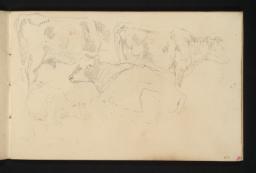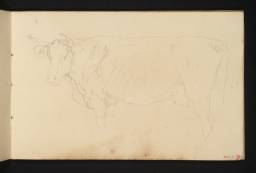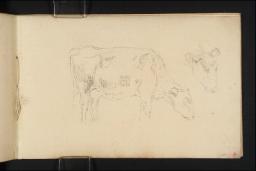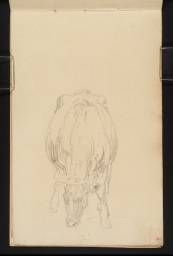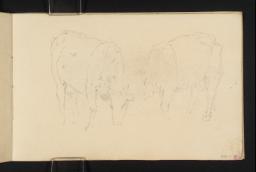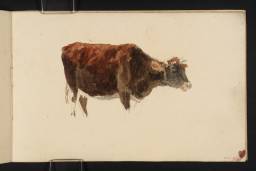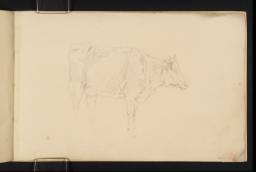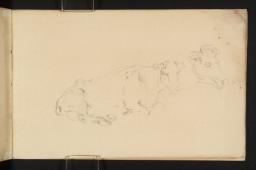J.M.W. Turner
>
1787-1801 Student and master
>
History Painting c.1799-1807
>
Cows Sketchbook
Turner Bequest LXII 1–13a
Sketchbook lacking covers, bound in modern buff paper wrapper
14 leaves of cream laid writing paper; 117 x 184 mm; watermark ‘king’ with fleur-de-lys emblem (trimmed)
Made by John Larking, of Upper Paper Mill, East Malling, Kent
Inscribed by Turner in ink ‘106’ on parchment label tipped in on folio 1 recto (D03721)
Numbered 220 as part of the Turner Schedule in 1854, and endorsed by the Executors of the Turner Bequest on the verso of folio 1 (D03721)
14 leaves of cream laid writing paper; 117 x 184 mm; watermark ‘king’ with fleur-de-lys emblem (trimmed)
Made by John Larking, of Upper Paper Mill, East Malling, Kent
Inscribed by Turner in ink ‘106’ on parchment label tipped in on folio 1 recto (D03721)
Numbered 220 as part of the Turner Schedule in 1854, and endorsed by the Executors of the Turner Bequest on the verso of folio 1 (D03721)
Accepted by the nation as part of the Turner Bequest 1856
References
1909
A.J. Finberg, A Complete Inventory of the Drawings of the Turner Bequest, London 1909, vol.I, pp.164–5 LXII 1–13a (as ‘Cows Sketch Book’ c.1801).
1990
Peter Bower, Turner’s Papers: A Study of the Manufacture, Selection and Use of his Drawing Papers 1787–1820, exhibition catalogue, Tate Gallery, London 1990, p.62 note 7.
The collection of studies of cows that this sketchbook contains is consistent with Turner’s occasional habit of devoting a separate book to staffage; see for instance the 1801 Scotch Figures sketchbook (Tate; Turner Bequest LIX) and the 1802 Swiss Figures sketchbook (Tate; Turner Bequest LXXVIII). In this instance, Turner pays homage to a staple of the Picturesque as defined by the Reverend William Gilpin (1724–1804), the foreground group of three or five (but not two or four) cows, odd numbers of cows and sheep always being preferable.1
Many of Turner’s watercolours of this early period, and indeed much later, incorporate cows drawn on a large scale; examples are St Agatha’s Abbey, Easby, Yorkshire (Whitworth Art Gallery, Manchester),2 St Donat’s Castle, South Wales: Summer Evening of 1801 (private collection)3 and Edinburgh, from Caulton-hill, exhibited in 1804 (Tate D03639; Turner Bequest LX H).4 He may have continued to refer to the book some years later; see for instance the painting The Quiet Ruin, Cattle in Water; A Sketch, Evening (Tate N00487),5 possibly shown in Turner’s gallery in 1809. Specific links have been proposed between another oil painting of about 1809 with the drawings on folios 10 recto and 13 recto (D03731, D03734). But Turner may have made these studies simply to acquaint himself more fully with the anatomy and general demeanour of cows.
Other studies of cows are scattered through the Turner Bequest; see for example the Brocklesby Mausoleum sketchbook (Tate D05164; Turner Bequest LXXXIII 6) and the Helmsley sketchbook (Tate D02527; Turner Bequest LIII 39). A study of cows in the possession of the Reverend W. Kingsley was referred to by John Ruskin in a diary entry summarising his intentions for an unrealised section on ‘Water Beauty’ for Modern Painters.6 Finberg gives c.1801 as the date of this book,7 which appears to be confirmed on technical grounds as the earliest possible date (see the technical notes below).
See Gilpin’s Observations Relative Chiefly to Picturesque Beauty Made in the Year 1772, on Several Parts of England, Particularly the Mountains, and Lakes of Cumberland, and Westmoreland, London 1786, vol.II, section XXXI, p.258; compare Jane Austen’s Pride and Prejudice (1813), chapter X: ‘You are charmingly group’d, and appear to uncommon advantage. The picturesque would be spoilt by admitting a fourth.’
Martin Butlin and Evelyn Joll, The Paintings of J.M.W. Turner, revised ed., New Haven and London 1984, pp.62–3 no.83, pl.93.
Technical notes
In 1990 Peter Bower identified the paper as by John Larking of Upper Paper Mill, East Malling, Kent, as is that in the Composition Studies sketchbook (Tate; Turner Bequest LXV), used in about 18058 (see the ‘Thame sketchbooks c.1804–14’ section of this catalogue. Bower later noted in detail that the format is a heavily trimmed Demy Octavo. The paper was made on a single-faced mould, and the drawings were worked on the feltside of the leaves, which appear to be the matching other halves of sheets in the Composition Studies book, where the partial ‘J Lar’ and crowned fleur-de-lys watermarks with the letter ‘L’ and date ‘[1]801’ on many pages correspond with the ‘king’s and partial emblems here. Larking’s high-quality papers were expensive and unlikely to have been used for ready-made memoranda books. The two books may have been ‘homemade by Turner himself’,9 or perhaps commercially to his specification, as discussed in the Introduction to the Composition Studies book, where similar sketchbooks of the period are compared.
The format of this book is also virtually identical to that of the On a Lee Shore (1) and (2) sketchbooks (Tate; Turner Bequest LXVII, LXVIII), but the white laid pages, by a different maker, have been left unwashed, and instead of eight leaves in those cases there are fourteen here. The last is blank and not listed by Finberg, despite having clearly always been integral with the first (D03721), but it is stamped in black ‘LXII 14’ in series with the rest beside the bottom right corner, which appears to have been torn away and made up with similar paper.
In 1909 Finberg described ‘Turner’s label at back’,10 his usual term for a sketchbook’s spine, suggesting that it was in its present position, that is, glued round the fold of the outer sheet as a form of spine, and that there was therefore no cover originally. Although it was presumably once pasted round onto the verso of folio 14, now only the front half on folio 1 recto (D03721) adheres, with the other half folded between it and the modern front cover, apparently to avoid the three stitch holes by which the gathering is attached to the new wrapper and thereby leave Turner’s ink number legible along the crease. It is inscribed ‘106’, while those on the On a Lee Shore books are numbered ‘104’ and ‘103’ respectively.
Andrew Wilton
May 2013
Revised by Matthew Imms
April 2016
-
-
-
-
Joseph Mallord William TurnerCows SketchbookD03724
-
-
-
-
-
-
-
-
-
-
-
How to cite
Andrew Wilton, ‘Cows sketchbook c.1801’, sketchbook, May 2013, revised by Matthew Imms, April 2016, in David Blayney Brown (ed.), J.M.W. Turner: Sketchbooks, Drawings and Watercolours, Tate Research Publication, April 2016, https://www

